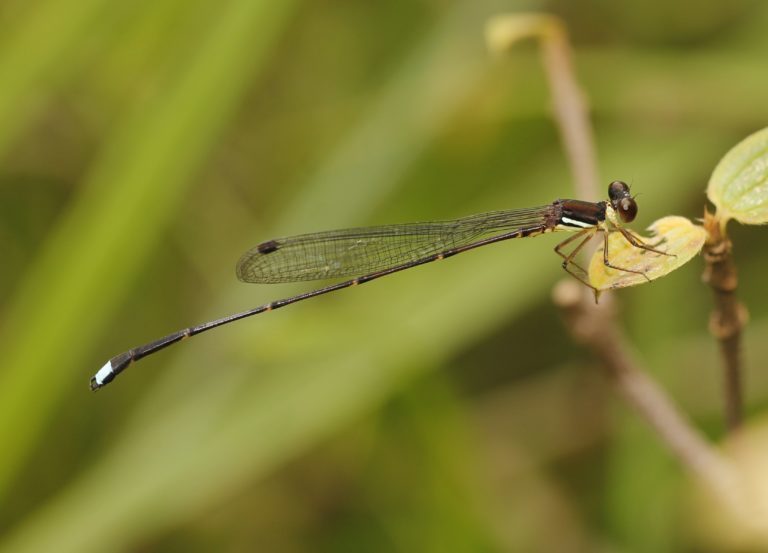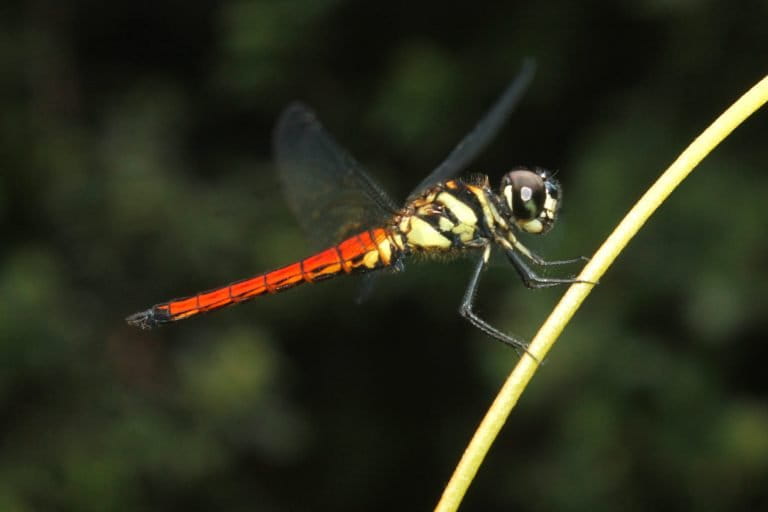- The rate of global warming has made thousands of species highly vulnerable, and in Sri Lanka, among the most vulnerable are the odonates: dragonflies and damselflies.
- Increasingly unfavorable climate conditions mean that in their short life span of just a few weeks, they stand a lower chance of successful reproduction and higher odds of mortality, research has shown.
- A 2017 preliminary study in Sri Lanka using climate modeling of current and predicted climate data shows how the distribution ranges of threatened and endemic odonates will shrink by 2050, leading to local or even global extinctions.
- This post is a commentary. The views expressed are those of the author, not necessarily Mongabay.
As climate change impact dramatically alters the world we live in, the biodiversity around us is also experiencing rapid and alarming changes.
For dragonflies and damselflies (odonates), having an amphibious life cycle with an exclusively aquatic larval stage and a terrestrial adult stage, the changing climate has both direct and indirect impacts. These gossamer-feathered, highly seasonal creatures emerge as adults during specific periods of the year and live only a few weeks as adults. This short life span adds to the vulnerability they experience owing to climatic change.
Laboratory experiments conducted on developing odonate larvae by exposing them to different water temperatures have shown that they tend to experience higher mortality rates at higher temperatures. It has also been observed that the individuals that develop in warmer water tend to develop smaller wings compared to body size. As the relative wing size decreases they will experience a higher wing load, making these individuals have less dispersal ability compared to other individuals.
Higher water temperatures also cause the larvae to develop more quickly and emerge as adults sooner, thus affecting seasonality. This matters to odonates, because they time their emergence with seasonal changes in their environment. In Sri Lanka, most odonates emerge with the onset of the monsoon rains and are active throughout the monsoon season. Some of the wet-zone forest-dwelling endemics, in particular, are only seen on the wing between April and October, while the dry-zone species are more abundant between November and April.

Reduced reproduction, increased mortality
With indications of changes in rainfall patterns over recent years, the untimely emergence of adult dragonflies and damselflies is likely to expose them to less favorable conditions. As they only have a few weeks to live and reproduce, the unfavorable conditions they face can reduce their chances of successful reproduction and also cause direct mortality.
Other than the direct impacts of increased water temperature during the larval period, the changing climate can also have impacts on the distribution of dragonflies and damselflies. Species distribution is often governed by their tolerance level to different climatic conditions. The changing patterns of rainfall and temperature can increase or decrease the area suitable to each species with time.
As a result of this, species that are able to tolerate wider climatic conditions might see an increase in their distribution ranges, while many species with narrow ranges might experience a reduction in suitable ranges. Species confined to mountains would be especially negatively affected.
As mountains are cooler than the surrounding lowlands, the species confined to these habitats are already adapted to lower temperatures. As the temperature in mountains increases, they would tend to shift their distribution upward along the elevation gradient and will be confined to even less area than present or face extinction.

Distribution range shifts can have other negative impacts on species apart from shrinking of suitable habitats. When a species shifts its range toward another area, it might increase the overlap between similar species competing for the available resources. This can even cause a competitive exclusion of the less fit species and might lead to local extinctions.
An experimental study done on two related damselfly species in Europe has explored the effects of range shifts further. The two selected species have partially overlapping ranges; biologists introduced one species to an area of the other species where they do not co-occur naturally. As a result, they observed that the males of the native species tended to misidentify the females of the introduced species as females of their own species and attempted to mate with them. That would lead to hybridization of species and reduce their reproductive success.

Climate modeling in Sri Lanka
It has been predicted that the intermediate climate zone of Sri Lanka would expand eastward by 2050 based on predicted global climatic scenarios. A preliminary study conducted in 2017 by modeling the distribution ranges of threatened and endemic odonates of Sri Lanka using the current and predicted climatic data shows that a majority of species studied would see their range shrink by 2050. Montane-specific species such as the critically endangered smoky-winged threadtail (Elattoneura leucostigma) would be drastically impacted by this, with an alarming shrink in the size of climatically suitable range that could even lead to possible extinction.
Many forest-dwelling montane endemics with restricted ranges confined to a single mountain range, such as the numerous shadowdamsel species (Ceylonosticta spp.) of the highlands, might face the same future.
Some species confined to the southwestern wet zone, such as the critically endangered Sri Lanka vermilion forester (Lyriothemis defonsekai), could see an expansion of climatically suitable habitats eastward beyond the central highlands. But as the highlands act as a geographical barrier, they might not expand their range toward that direction. Only some of the more tolerant species occurring outside core forest areas were observed to show range expansions.

Considering the results of the experimental studies, field observations and modeling based on predicted future climatic conditions, it is evident that dragonflies and damselflies would generally face a grim future in the coming decades due to the rapid changes in climatic patterns.
Though these are ancient insects well adapted to their environments, the rapid rate of changes occurring at present due to anthropogenic activities would strike them hard, leading some species to local or even global extinctions. Unfortunately, this might even lead to the extinction of certain species yet unknown to science even before we discover them, especially in less taxonomically explored tropical countries like Sri Lanka. Our current work, supported by The Rufford Foundation, is focused on understanding these impacts at a local scale, specifically in terms of montane fauna in Sri Lanka, and finding a way forward with identifying priority areas to conserve while mitigating the adverse impacts of climate change to save our endemic odonates threatened with extinction.
Amila Prasanna Sumanapala is a field researcher studying the faunal biodiversity of Sri Lanka. He is currently doing postgraduate work on Sri Lankan Odonata, the order of carnivorous insects that include dragonflies and damselflies, and has more than a decade of experience in biodiversity research and assessments. He is the author of the 2017 Field Guide to the Dragonflies and Damselflies of Sri Lanka.
References:
Hassall, C., & Thompson, D. J. (2008). The effects of environmental warming on Odonata: A review. International Journal of Odonatology, 11(2), 131-153. doi:10.1080/13887890.2008.9748319
McCauley, S. J., Hammond, J. I., & Mabry, K. E. (2018). Simulated climate change increases larval mortality, alters phenology, and affects flight morphology of a dragonfly. Ecosphere, 9(3), e02151. doi:10.1002/ecs2.2151
Sánchez-Guillén, R. A., Córdoba-Aguilar, A., Hansson, B., Ott, J., & Wellenreuther, M. (2015). Evolutionary consequences of climate-induced range shifts in insects. Biological Reviews, 91(4), 1050-1064. doi:10.1111/brv.12204
Sumanapala, A. P. (2017). The future of endemic Odonata in Sri Lanka under changing climatic patterns. In International Congress on Odonatology. Cambridge: Clare College.
Wellenreuther, M., Tynkkynen, K., & Svensson, E. I. (2009). Simulating range expansion: Male species recognition and loss of premating isolation in damselflies. Evolution, 64(1), 242-252. doi:10.1111/j.1558-5646.2009.00815.x
Banner image of a smoky-winged threadtail resting on a leaf, courtesy of Amila Prasanna Sumanapala.
